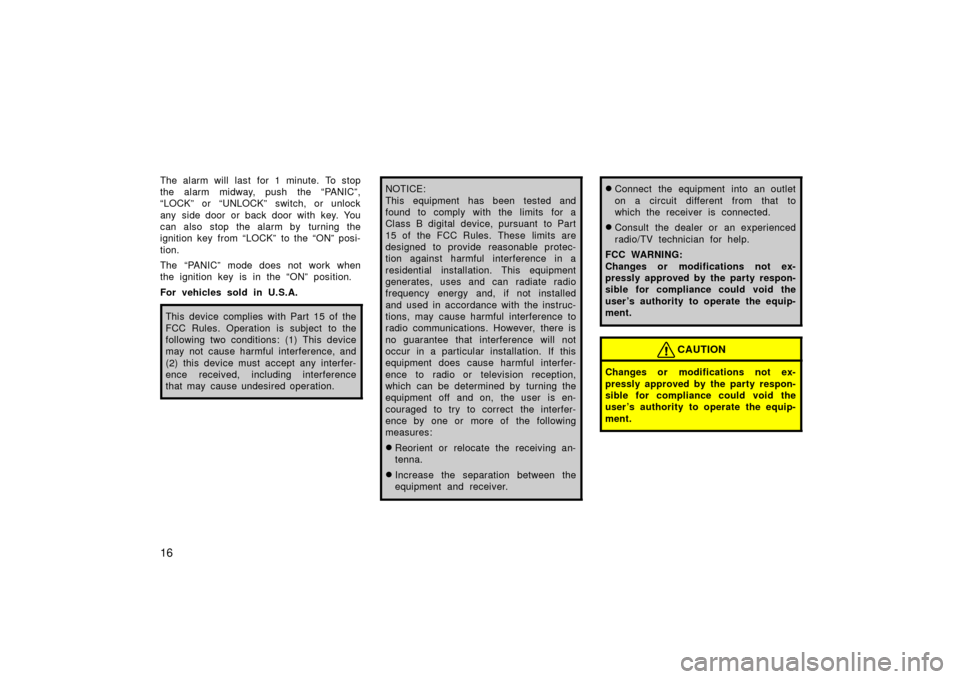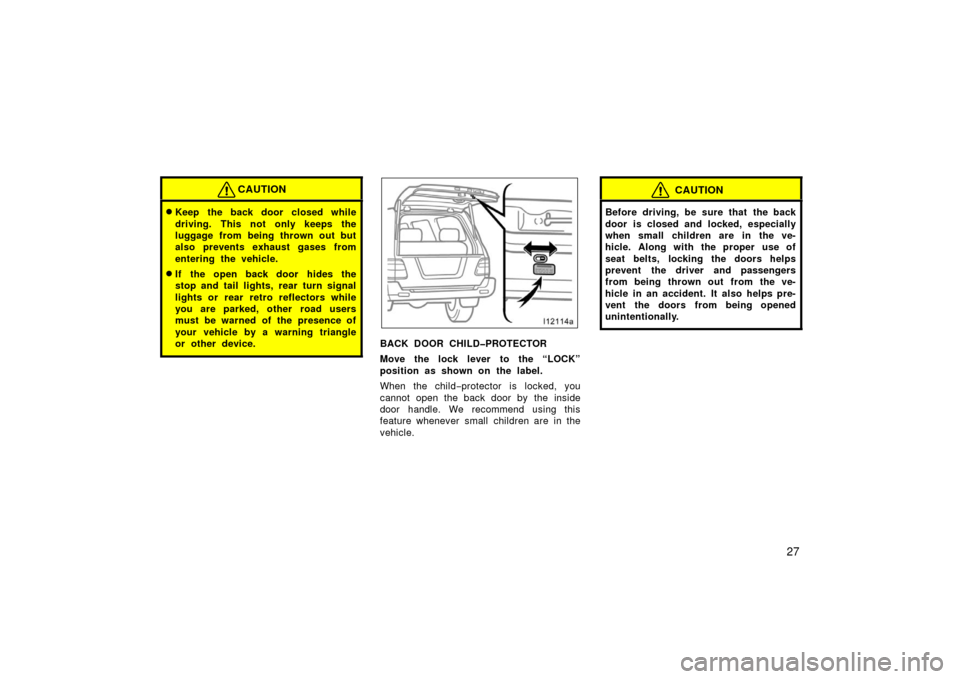Page 2 of 364
ii
Important information about this manual
Safety and vehicle damage warnings
Throughout this manual, you will see safety and vehicle dam-
age warnings. You must follow these warnings carefully to
avoid possible injury or damage.
The types of warnings, what they look like, and how they are
used in this manual are explained as follows:
CAUTION
This is a warning against anything which may
cause injury to people if the warning is ignored.
You are informed about what you must or must not
do in order to reduce the risk of injury to yourself
and others.
NOTICE
This is a warning against anything which may
cause damage to the vehicle or its equipment if the
warning is ignored. You are informed about what
you must or must not do in order to avoid or re-
duce the risk of damage to your vehicle and its
equipment.
Safety symbol
When you see the safety symbol
shown above, it means: “Do not”; “Do
not do this”; or “Do not let this hap-
pen”.
Page 6 of 364

vi
New vehicle warranty
Your new vehicle is covered by the following Toyota
limited warranties:� New vehicle warranty
� Emission control systems warranty
� Others
For further information, please refer to the “Owner’s
Warranty Information Booklet” or “Owner ’s Manual Sup-
plement”.
Your responsibility for maintenance
It is the owner ’s responsib ility to make sure the speci-
fied maintenance is performed. Section 6 gives details
of these maintenance requirements. Also included in
Section 6 is general maintenance. For scheduled mainte-
nance information, place refer to the “Scheduled Mainte-
nance Guide” or “Owner ’s Manual Supplement”.
Important health and safety
information about your Toyota
CAUTION
�WARNING: Engine exhaust, some of its constitu-
ents, and a wide variety of automobile compo-
nents contain or emit chemicals known to the
State of California to cause cancer and birth de-
fects and other reproductive harm. In addition,
oils, fuels and fluids contained in vehicles as well
as waste produced by component wear contain or
emit chemicals known to the State of California
to cause cancer and birth defects or other repro-
ductive harm.
�Battery posts, terminals and related accessories
contain lead and lead compounds. Wash your
hands after handling. Used engine oil contains
chemicals that have caused cancer in laboratory
animals. Always protect your skin by washing
thoroughly with soap and water.
Page 13 of 364
3
1. Headlight, turn signal and front foglight switches
2. Cruise control switch
3. Ignition switch
4. Wiper and washer switches
5. Emergency flasher switch
6. Navigation system including air condi- tioning controls (See the separate
“Navigation System Owner ’s Manual”.)
7. Clock and outside temperature display
8. Front passenger ’s seat belt reminder light
9. Audio system
10. Outside rear view mirror heater switch 11. Rear air conditioning switch
12. Rear window defogger switch
13. Center differential lock switch
14. Power antenna switch
15. Power tilt and telescopic steering switch
16. Instrument panel light control dial
17. Power rear view mirror control switches
18. Tire pressure warning system reset switch
19. Power quarter window switch (left− hand side)
20. Power quarter window switch (right −hand side)
21. Roll sensing of curtain shield airbags off switch
�
View B
(Vehicles with navigation system)
11C515b
Page 14 of 364
4
1. Headlight, turn signal and front foglight switches
2. Cruise control switch
3. Ignition switch
4. Wiper and washer switches
5. Emergency flasher switch
6. Clock, outside temperature and trip in- formation display
7. Audio system
8. Front passenger ’s seat belt reminder light
9. Air conditioning controls
10. Outside rear view mirror heater switch 11. Rear air conditioning switch
12. Rear window defogger switch
13. Center differential lock switch
14. Power antenna switch
15. Power tilt and telescopic steering switch
16. Instrument panel light control dial
17. Power rear view mirror control switches
18. Tire pressure warning system reset switch
19. Power quarter window switch (left− hand side)
20. Power quarter window switch (right −hand side)
21. Roll sensing of curtain shield airbags off switch
�
View B
(Vehicles without navigation system)
11C029d
Page 17 of 364
7
Indicator symbols on the instrument panel
Brake system warning light∗1
Malfunction indicator lamp∗1Headlight high beam indicator light Turn signal indicator lights
Driver ’s seat belt reminder light∗1
Anti −lock brake system warning light∗
1
Open door warning light∗1
SRS warning light∗1
Low fuel level warning light∗1
Automatic transmission fluid temperature warning
light∗1
Unengaged “Park” warning light∗1
Charging system warning light∗1
Engine oil replacement reminder light
Center differential lock indicator light Driving pattern (“POWER” mode) indicator
light
Automatic transmission second start indicator
light
Cruise control indicator light∗2
Low tire pressure warning light∗1
Page 18 of 364
8
∗1: For details, see “Service reminder indicators and warning
buzzers” on page 124.
∗2: If this light flashes, see “Cruise control” on page 155.
∗3: For details, see “Roll sensing of curtain shield airbags off
switch” on page 68.
Vehicle stability control system off indicator
light∗1
Vehicle stability control system and active
traction control system warning light∗1
Active traction control system indicator light
Slip indicator light
Roll sensing of curtain shield airbags off indicator light∗ 3
Automatic transmission indicator lights
Page 26 of 364

16
The alarm will last for 1 minute. To stop
the alarm midway, push the “PANIC”,
“LOCK” or “UNLOCK” switch, or unlock
any side door or back door with key. You
can also stop the alarm by turning the
ignition key from “LOCK” to the “ON” posi-
tion.
The “PANIC” mode does not work when
the ignition key is in the “ON” position.
For vehicles sold in U.S.A.
This device complies with Part 15 of the
FCC Rules. Operation is subject to the
following two conditions: (1) This device
may not cause harmful interference, and
(2) this device must accept any interfer-
ence received, including interference
that may cause undesired operation.
NOTICE:
This equipment has been tested and
found to comply with the limits for a
Class B digital device, pursuant to Part
15 of the FCC Rules. These limits are
designed to provide reasonable protec-
tion against harmful interference in a
residential installation. This equipment
generates, uses and can radiate radio
frequency energy and, if not installed
and used in accordance with the instruc-
tions, may cause harmful interference to
radio communications. However, there is
no guarantee that interference will not
occur in a particular installation. If this
equipment does cause harmful interfer-
ence to radio or television reception,
which can be determined by turning the
equipment off and on, the user is en-
couraged to try to correct the interfer-
ence by one or more of the following
measures:
�Reorient or relocate the receiving an-
tenna.
�Increase the separation between the
equipment and receiver.
�Connect the equipment into an outlet
on a circuit different from that to
which the receiver is connected.
�Consult the dealer or an experienced
radio/TV technician for help.
FCC WARNING:
Changes or modifications not ex-
pressly approved by the party respon-
sible for compliance could void the
user’s authority to operate the equip-
ment.
CAUTION
Changes or modifications not ex-
pressly approved by the party respon-
sible for compliance could void the
user’s authority to operate the equip-
ment.
Page 37 of 364

27
CAUTION
�Keep the back door closed while
driving. This not only keeps the
luggage from being thrown out but
also prevents exhaust gases from
entering the vehicle.
�If the open back door hides the
stop and tail lights, rear turn signal
lights or rear retro reflectors while
you are parked, other road users
must be warned of the presence of
your vehicle by a warning triangle
or other device.
BACK DOOR CHILD�PROTECTOR
Move the lock lever to the “LOCK”
position as shown on the label.
When the child−protector is locked, you
cannot open the back door by the inside
door handle. We recommend using this
feature whenever small children are in the
vehicle.
CAUTION
Before driving, be sure that the back
door is closed and locked, especially
when small children are in the ve-
hicle. Along with the proper use of
seat belts, locking the doors helps
prevent the driver and passengers
from being thrown out from the ve-
hicle in an accident. It also helps pre-
vent the doors from being opened
unintentionally.